Abstract
The capacity of in vitro bioassays to detect the potential carcinogenicity of metal compounds is reviewed. The in vitro bioassays discussed include: bacterial reversion analysis to determine the capacity of metal salts to revert Salmonella typhimurium histidine auxotrophs or to revert Escherichia coli WP 2 tryp- to tryptophan prototrophy; examination of the ability of metal salts to preferentially inhibit cell growth in Bacillus subtilis cells deficient in DNA repair pathways; determination of the ability of metal salts to induce resistance to base analogs in mammalian cells; the capacity of metal salts to enhance viral transformation of mammalian cells or to transform cells in the absence of virus; and the ability of metal salts to induce chromosomal aberrations in mammalian cells. Using each of these in vitro bioassays, diverse metal compounds have been identified as potential carcinogens. Furthermore, the use of different compounds of a specific metal may allow a determination of the valence which may be required for carcinogenesis.
Full text
PDF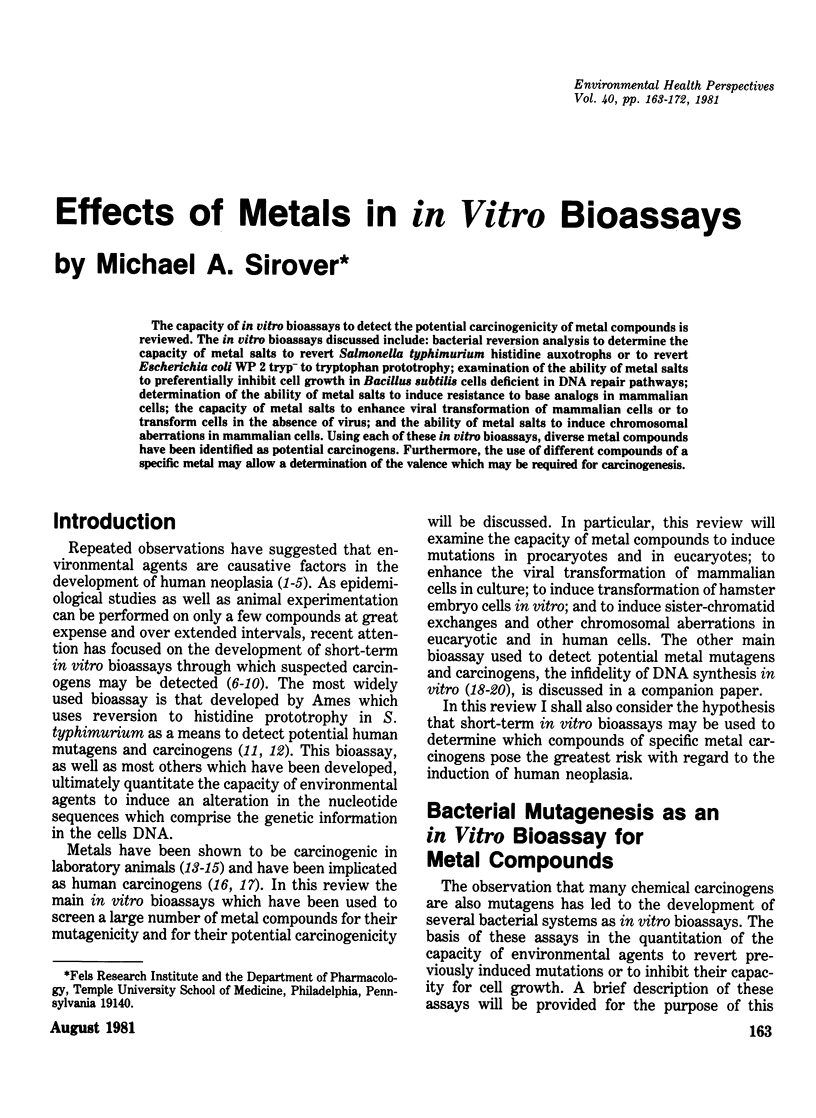
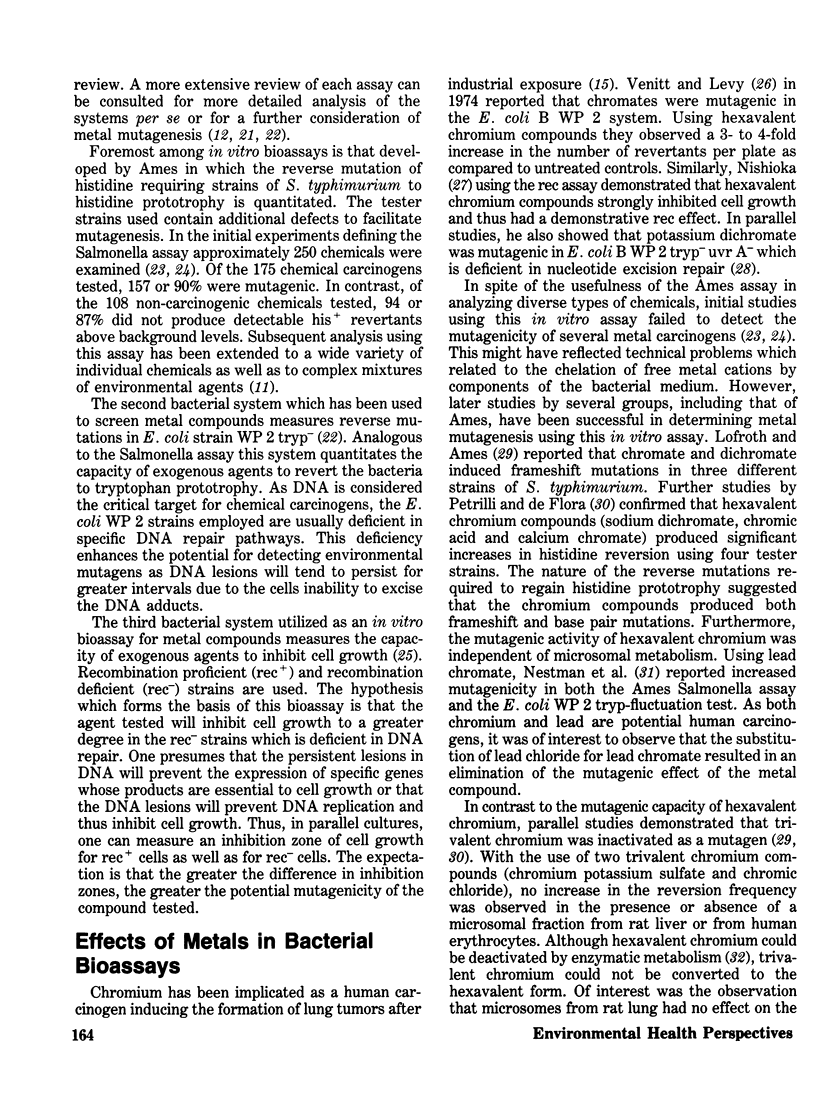
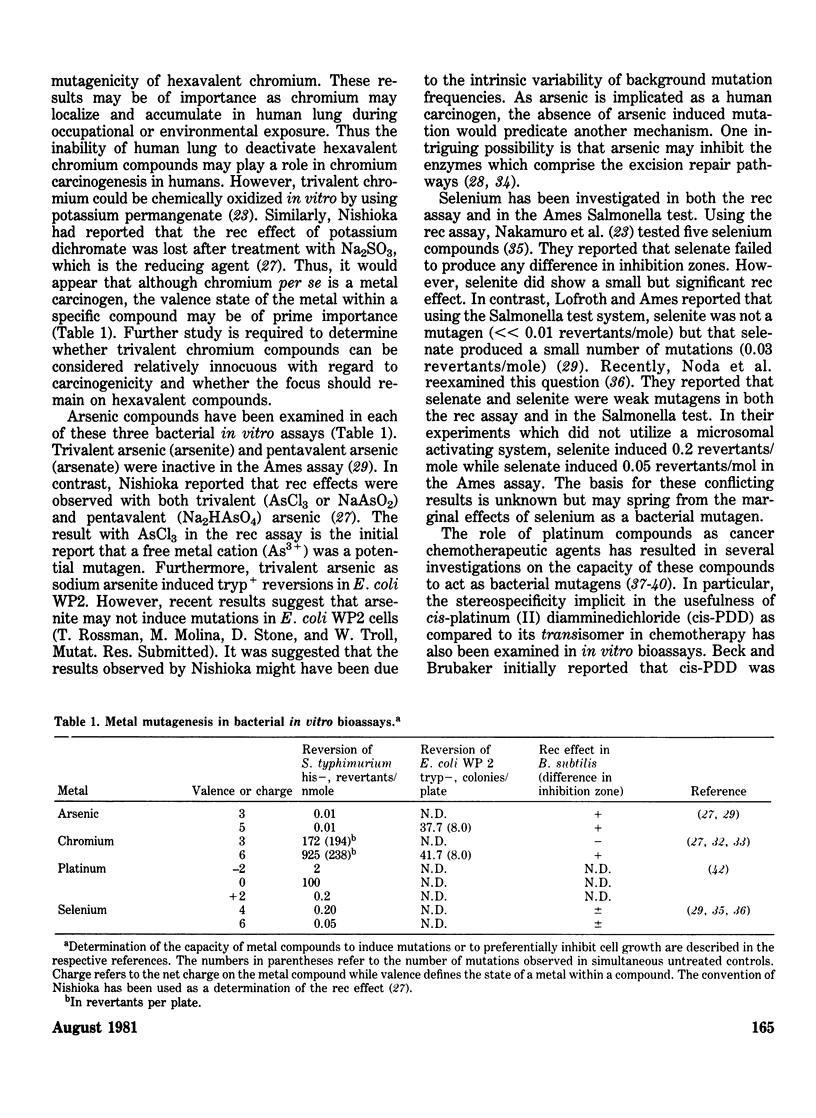
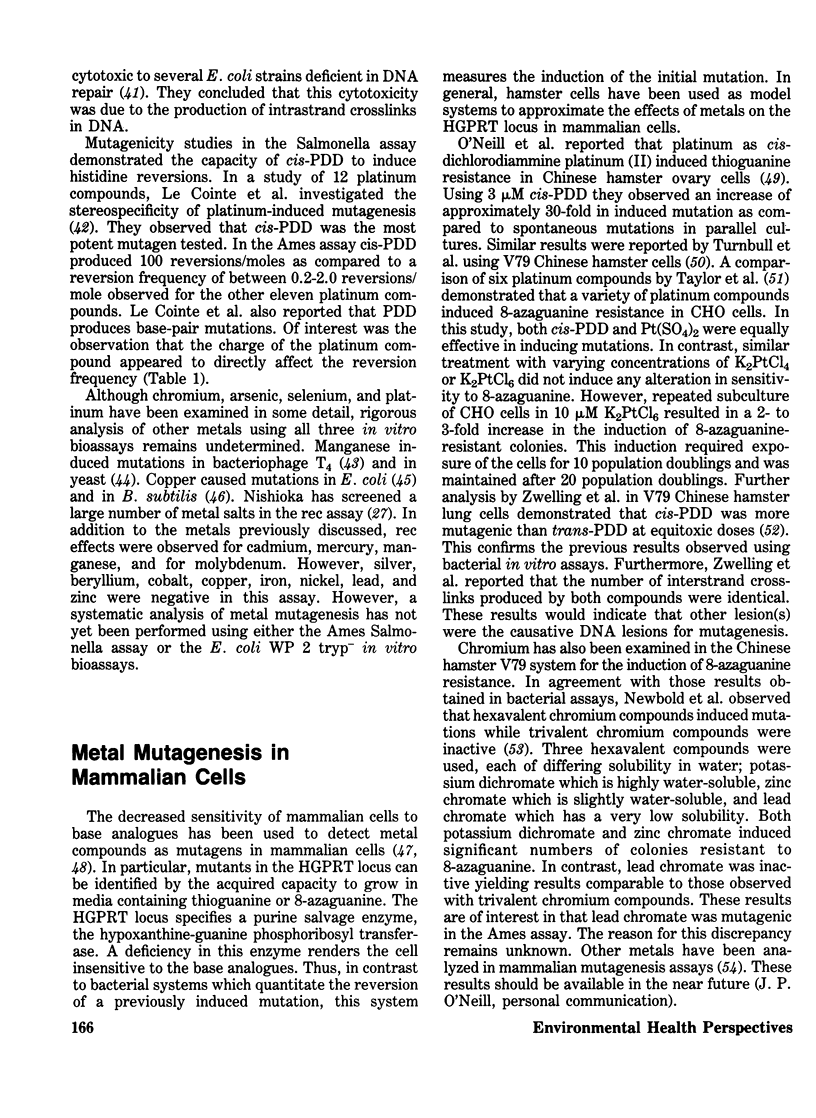
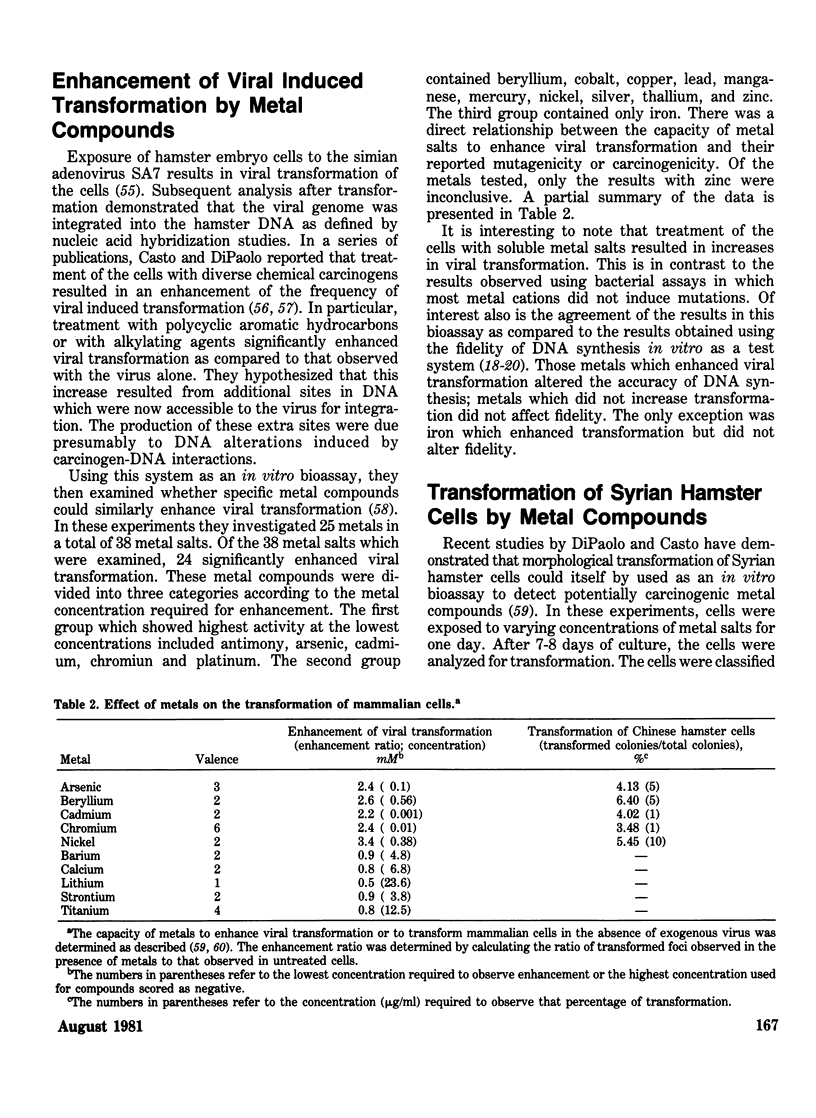
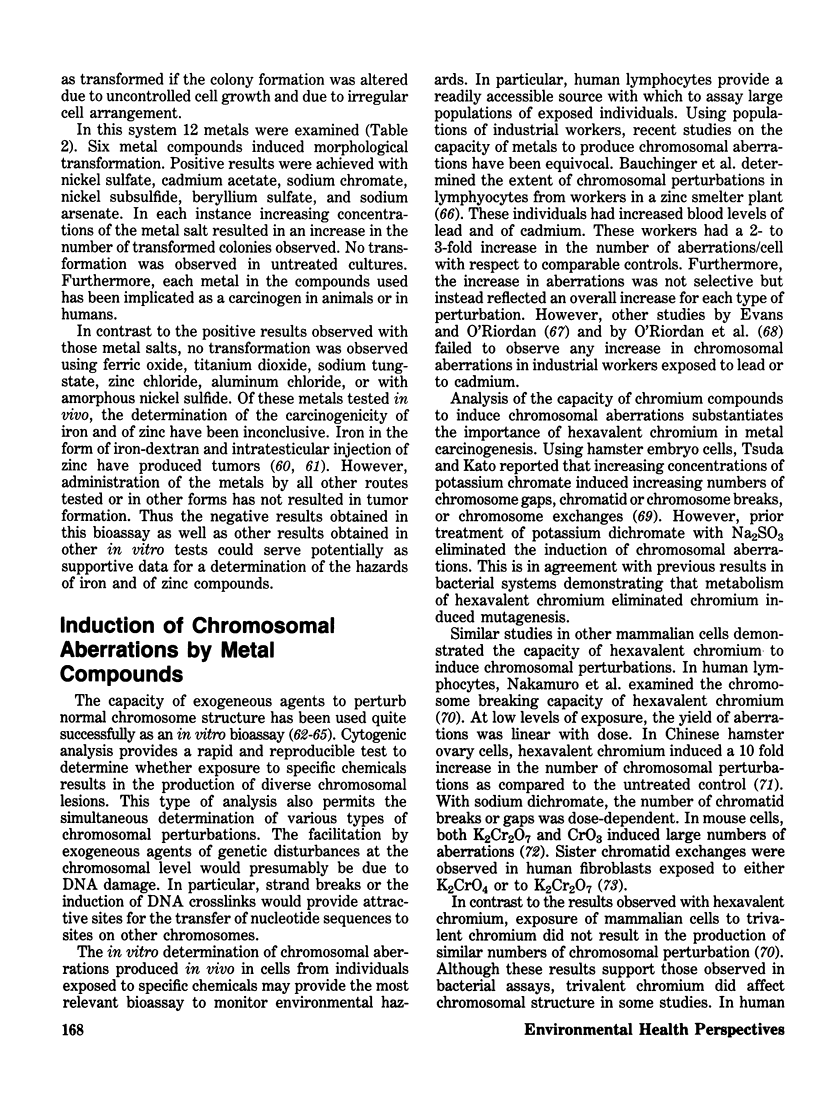
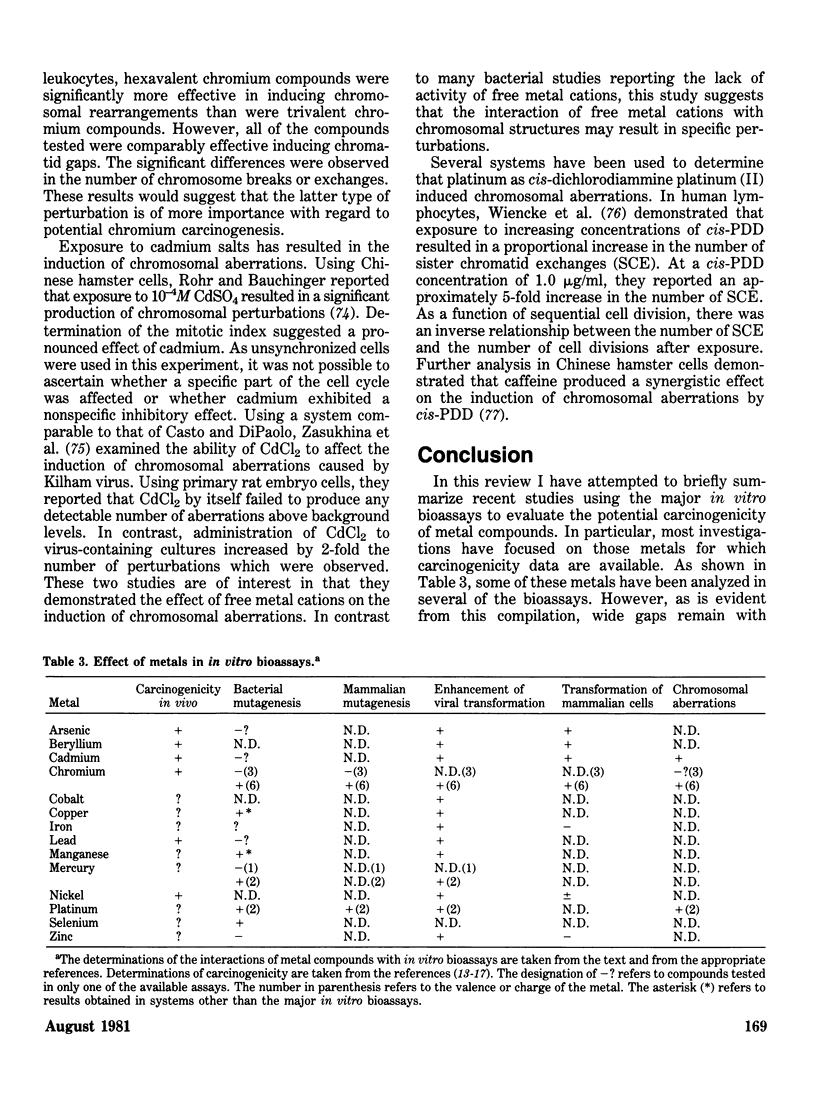
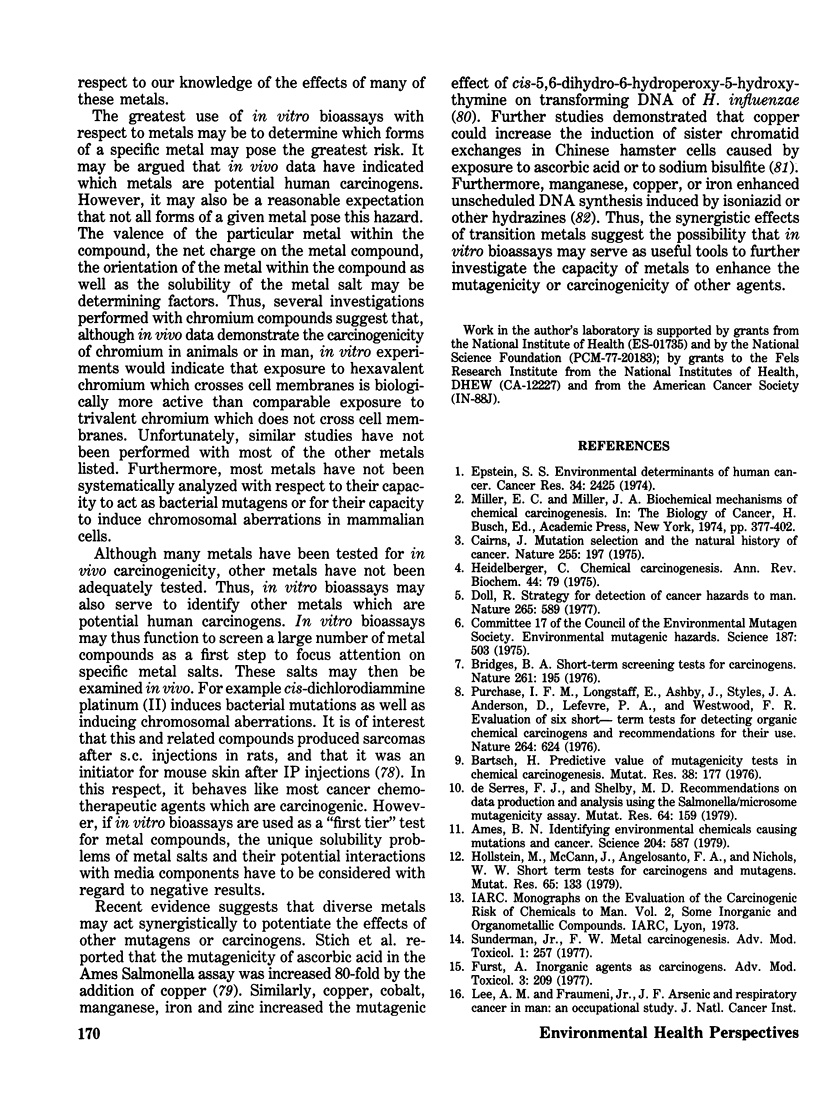
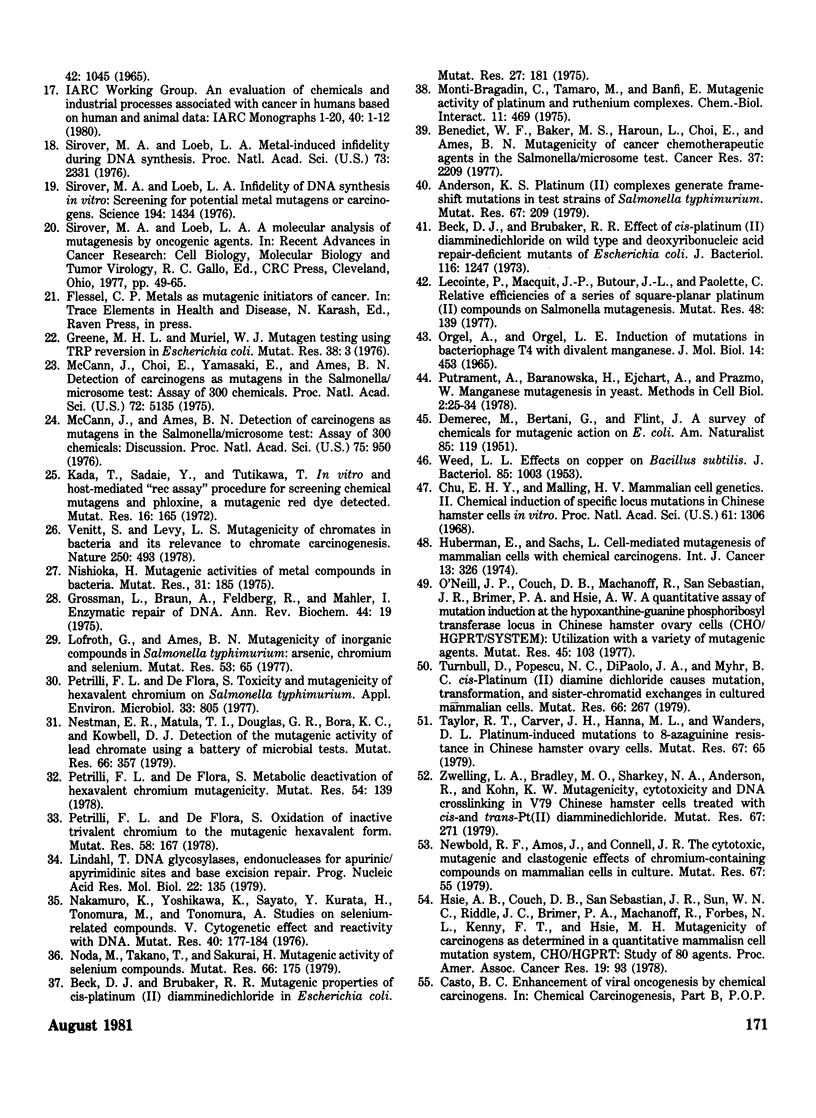
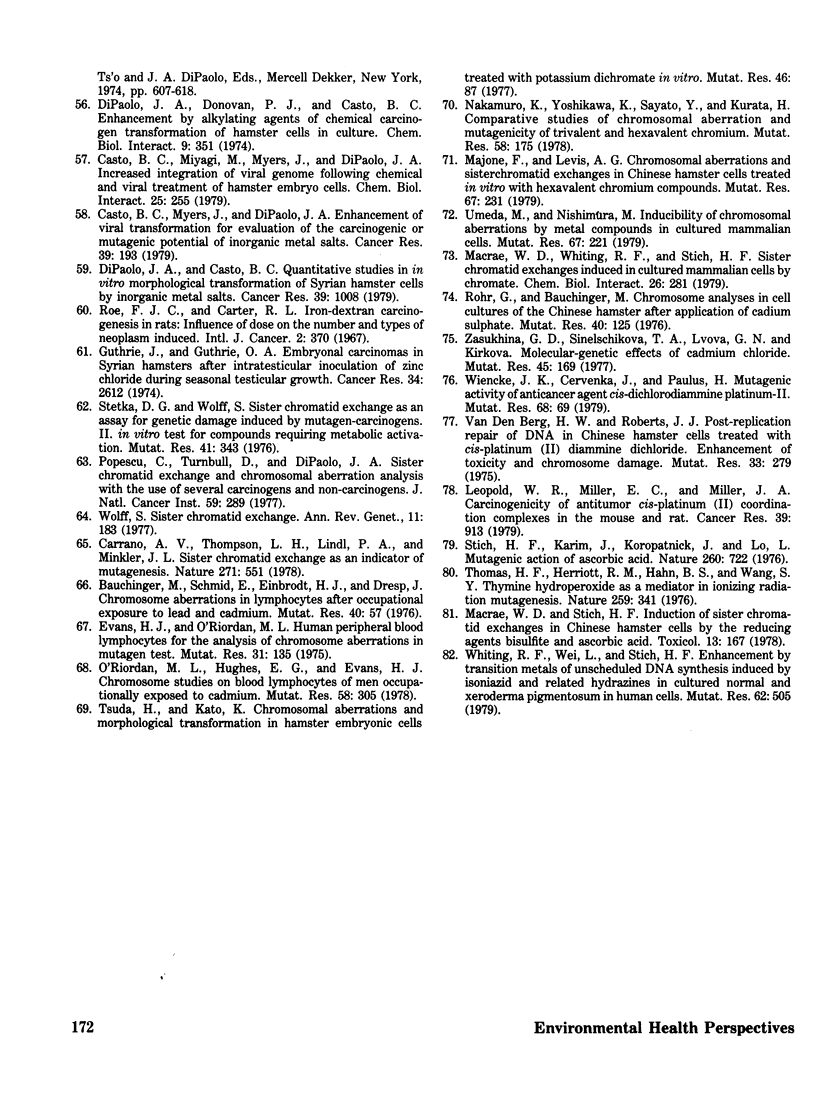
Selected References
These references are in PubMed. This may not be the complete list of references from this article.
- Ames B. N. Identifying environmental chemicals causing mutations and cancer. Science. 1979 May 11;204(4393):587–593. doi: 10.1126/science.373122. [DOI] [PubMed] [Google Scholar]
- Andersen K. S. Platinum(II) complexes generate frame-shift mutations in test strains of Salmonella typhimurium. Mutat Res. 1979 Jul;67(3):209–214. doi: 10.1016/0165-1218(79)90014-4. [DOI] [PubMed] [Google Scholar]
- Bartsch H. Predictive value of mutagenicity tests in chemical carcinogenesis. Mutat Res. 1976 Jun;38(3):177–190. doi: 10.1016/0165-1161(76)90189-8. [DOI] [PubMed] [Google Scholar]
- Beck D. J., Brubaker R. R. Effect of cis-platinum(II)diamminodichloride on wild type and deoxyribonucleic acid repair deficient mutants of Escherichia coli. J Bacteriol. 1973 Dec;116(3):1247–1252. doi: 10.1128/jb.116.3.1247-1252.1973. [DOI] [PMC free article] [PubMed] [Google Scholar]
- Beck D. J., Brubaker R. R. Mutagenic properties of cis-plantinum(II)diammino-dichloride in Escherichia coli. Mutat Res. 1975 Feb;27(2):181–189. doi: 10.1016/0027-5107(75)90077-9. [DOI] [PubMed] [Google Scholar]
- Benedict W. F., Baker M. S., Haroun L., Choi E., Ames B. N. Mutagenicity of cancer chemotherapeutic agents in the Salmonella/microsome test. Cancer Res. 1977 Jul;37(7 Pt 1):2209–2213. [PubMed] [Google Scholar]
- Bridges B. A. Short term screening tests for carcinogens. Nature. 1976 May 20;261(5557):195–200. doi: 10.1038/261195a0. [DOI] [PubMed] [Google Scholar]
- Cairns J. Mutation selection and the natural history of cancer. Nature. 1975 May 15;255(5505):197–200. doi: 10.1038/255197a0. [DOI] [PubMed] [Google Scholar]
- Carrano A. V., Thompson L. H., Lindl P. A., Minkler J. L. Sister chromatid exchange as an indicator of mutagenesis. Nature. 1978 Feb 9;271(5645):551–553. doi: 10.1038/271551a0. [DOI] [PubMed] [Google Scholar]
- Casto B. C., Meyers J., DiPaolo J. A. Enhancement of viral transformation for evaluation of the carcinogenic or mutagenic potential of inorganic metal salts. Cancer Res. 1979 Jan;39(1):193–198. [PubMed] [Google Scholar]
- Casto B. C., Miyagi M., Meyers J., Di Paolo J. A. Increased integration of viral genome following chemical and viral treatment of hamster embryo cells. Chem Biol Interact. 1979 May;25(2-3):255–269. doi: 10.1016/0009-2797(79)90050-4. [DOI] [PubMed] [Google Scholar]
- Chu E. H., Malling H. V. Mammalian cell genetics. II. Chemical induction of specific locus mutations in Chinese hamster cells in vitro. Proc Natl Acad Sci U S A. 1968 Dec;61(4):1306–1312. doi: 10.1073/pnas.61.4.1306. [DOI] [PMC free article] [PubMed] [Google Scholar]
- DiPaolo J. A., Casto B. C. Quantitative studies of in vitro morphological transformation of Syrian hamster cells by inorganic metal salts. Cancer Res. 1979 Mar;39(3):1008–1013. [PubMed] [Google Scholar]
- DiPaolo J. A., Donovan P. J., Casto B. C. Enhancement by alkylating agents of chemical carcinogen transformation of hamster cells in culture. Chem Biol Interact. 1974 Nov;9(5):351–364. doi: 10.1016/0009-2797(74)90130-6. [DOI] [PubMed] [Google Scholar]
- Doll R. Strategy for detection of cancer hazards to man. Nature. 1977 Feb 17;265(5595):589–596. doi: 10.1038/265589a0. [DOI] [PubMed] [Google Scholar]
- Epstein S. S. Environmental determinants of human cancer. Cancer Res. 1974 Oct;34(10):2425–2435. [PubMed] [Google Scholar]
- Evans H. J., O'Riordan M. L. Human peripheral blood lymphocytes for the analysis of chromosome aberrations in mutagen tests. Mutat Res. 1975 Jun;31(3):135–148. doi: 10.1016/0165-1161(75)90082-5. [DOI] [PubMed] [Google Scholar]
- Green M. H., Muriel W. J. Mutagen testing using TRP+ reversion in Escherichia coli. Mutat Res. 1976 Feb;38(1):3–32. doi: 10.1016/0165-1161(76)90076-5. [DOI] [PubMed] [Google Scholar]
- Guthrie J., Guthrie O. A. Embryonal carcinomas in Syrian hamsters after intratesticular inoculation of zinc chloride during seasonal testicular growth. Cancer Res. 1974 Oct;34(10):2612–2614. [PubMed] [Google Scholar]
- Heidelberger C. Chemical carcinogenesis. Annu Rev Biochem. 1975;44:79–121. doi: 10.1146/annurev.bi.44.070175.000455. [DOI] [PubMed] [Google Scholar]
- Hollstein M., McCann J., Angelosanto F. A., Nichols W. W. Short-term tests for carcinogens and mutagens. Mutat Res. 1979 Sep;65(3):133–226. doi: 10.1016/0165-1110(79)90014-9. [DOI] [PubMed] [Google Scholar]
- Huberman E., Sachs L. Cell-mediated mutagenesis of mammalian cells with chemical carcinogens. Int J Cancer. 1974 Mar 15;13(3):326–333. doi: 10.1002/ijc.2910130308. [DOI] [PubMed] [Google Scholar]
- Kada T., Tutikawa K., Sadaie Y. In vitro and host-mediated "rec-assay" procedures for screening chemical mutagens; and phloxine, a mutagenic red dye detected. Mutat Res. 1972 Oct;16(2):165–174. doi: 10.1016/0027-5107(72)90177-7. [DOI] [PubMed] [Google Scholar]
- Lecointe P., Macquet J. P., Butour J. L., Paoletti C. Relative efficiencies of a series of square-planar plantinum(II) compounds on Salmonella mutagenesis. Mutat Res. 1977 Apr;48(2):139–143. doi: 10.1016/0027-5107(77)90153-1. [DOI] [PubMed] [Google Scholar]
- Leopold W. R., Miller E. C., Miller J. A. Carcinogenicity of antitumor cis-platinum(II) coordination complexes in the mouse and rat. Cancer Res. 1979 Mar;39(3):913–918. [PubMed] [Google Scholar]
- Lindahl T. DNA glycosylases, endonucleases for apurinic/apyrimidinic sites, and base excision-repair. Prog Nucleic Acid Res Mol Biol. 1979;22:135–192. doi: 10.1016/s0079-6603(08)60800-4. [DOI] [PubMed] [Google Scholar]
- MacRae W. D., Whiting R. F., Stich H. F. Sister chromatid exchanges induced in cultured mammalian cells by chromate. Chem Biol Interact. 1979 Aug;26(3):281–286. doi: 10.1016/0009-2797(79)90031-0. [DOI] [PubMed] [Google Scholar]
- Majone F., Levis A. G. Chromosomal aberrations and sister-chromatid exchanges in Chinese hamster cells treated in vitro with hexavalent chromium compounds. Mutat Res. 1979 Jul;67(3):231–238. doi: 10.1016/0165-1218(79)90017-x. [DOI] [PubMed] [Google Scholar]
- McCann J., Choi E., Yamasaki E., Ames B. N. Detection of carcinogens as mutagens in the Salmonella/microsome test: assay of 300 chemicals. Proc Natl Acad Sci U S A. 1975 Dec;72(12):5135–5139. doi: 10.1073/pnas.72.12.5135. [DOI] [PMC free article] [PubMed] [Google Scholar]
- Monti-Bragadin C., Tamaro M., Banfi E. Mutagenic activity of platinum and ruthenium complexes. Chem Biol Interact. 1975 Nov;11(5):469–472. doi: 10.1016/0009-2797(75)90014-9. [DOI] [PubMed] [Google Scholar]
- Nakamuro K., Yoshikawa K., Sayato Y., Kurata H. Comparative studies of chromosomal aberration and mutagenicity of the trivalent and hexavalent chromium. Mutat Res. 1978 Nov;58(2-3):175–181. doi: 10.1016/0165-1218(78)90007-1. [DOI] [PubMed] [Google Scholar]
- Nakamuro K., Yoshikawa K., Sayato Y., Kurata H., Tonomura M. Studies on selenium-related compounds. V. Cytogenetic effect and reactivity with DNA. Mutat Res. 1976 Jul;40(3):177–184. doi: 10.1016/0165-1218(76)90042-2. [DOI] [PubMed] [Google Scholar]
- Nestmann E. R., Matula T. I., Douglas G. R., Bora K. C., Kowbel D. J. Detection of the mutagenic activity of lead chromate using a battery of microbial tests. Mutat Res. 1979 Apr;66(4):357–365. doi: 10.1016/0165-1218(79)90046-6. [DOI] [PubMed] [Google Scholar]
- Newbold R. F., Amos J., Connell J. R. The cytotoxic, mutagenic and clastogenic effects of chromium-containing compounds on mammalian cells in culture. Mutat Res. 1979 May;67(1):55–63. doi: 10.1016/0165-1218(79)90099-5. [DOI] [PubMed] [Google Scholar]
- Nishioka H. Mutagenic activities of metal compounds in bacteria. Mutat Res. 1975 Jun;31(3):185–189. doi: 10.1016/0165-1161(75)90088-6. [DOI] [PubMed] [Google Scholar]
- Noda M., Takano T., Sakurai H. Mutagenic activity of selenium compounds. Mutat Res. 1979 Feb;66(2):175–179. doi: 10.1016/0165-1218(79)90063-6. [DOI] [PubMed] [Google Scholar]
- O'Neill J. P., Couch D. B., Machanoff R., San Sebastian J. R., Brimer P. A., Hsie A. W. A quantitative assay of mutation induction at the hypoxanthine-guanine phosphoribosyl transferase locus in Chinese hamster ovary cells (CHO/HGPRT system): utilization with a variety of mutagenic agents. Mutat Res. 1977 Oct;45(1):103–109. doi: 10.1016/0027-5107(77)90048-3. [DOI] [PubMed] [Google Scholar]
- O'Riordan M. L., Hughes E. G., Evans H. J. Chromosome studies on blood lymphocytes of men occupationally exposed to cadmium. Mutat Res. 1978 Nov;58(2-3):305–311. doi: 10.1016/0165-1218(78)90023-x. [DOI] [PubMed] [Google Scholar]
- Orgel A., Orgel L. E. Induction of mutations in bacteriophage T4 with divalent manganese. J Mol Biol. 1965 Dec;14(2):453–457. doi: 10.1016/s0022-2836(65)80195-4. [DOI] [PubMed] [Google Scholar]
- Petrilli F. L., De Flora S. Metabolic deactivation of hexavalent chromium mutagenicity. Mutat Res. 1978 Oct;54(2):139–147. doi: 10.1016/0165-1161(78)90034-1. [DOI] [PubMed] [Google Scholar]
- Petrilli F. L., De Flora S. Toxicity and mutagenicity of hexavalent chromium on Salmonella typhimurium. Appl Environ Microbiol. 1977 Apr;33(4):805–809. doi: 10.1128/aem.33.4.805-809.1977. [DOI] [PMC free article] [PubMed] [Google Scholar]
- Petrilli F. L., de Flora S. Oxidation of inactive trivalent chromium to the mutagenic hexavalent form. Mutat Res. 1978 Nov;58(2-3):167–173. doi: 10.1016/0165-1218(78)90006-x. [DOI] [PubMed] [Google Scholar]
- Popescu N. C., Turnbull D., DiPaolo J. A. Sister chromatid exchange and chromosome aberration analysis with the use of several carcinogens and noncarcinogens. J Natl Cancer Inst. 1977 Jul;59(1):289–293. doi: 10.1093/jnci/59.1.289. [DOI] [PubMed] [Google Scholar]
- Purchase I. F., Longstaff E., Ashby J., Styles J. A., Anderson D., Lefevre P. A., Westwood F. R. Evaluation of six short term tests for detecting organic chemical carcinogens and recommendations for their use. Nature. 1976 Dec 16;264(5587):624–627. doi: 10.1038/264624a0. [DOI] [PubMed] [Google Scholar]
- Roe F. J., Carter R. L. Iron-dextran carcinogenesis in rats: influence of dose on the number and types of neoplasm induced. Int J Cancer. 1967 Jul 15;2(4):370–380. doi: 10.1002/ijc.2910020412. [DOI] [PubMed] [Google Scholar]
- Röhr G., Bauchinger M. Chromosome analyses in cell cultures of the Chinese hamster after application of cadmiumsulphate. Mutat Res. 1976 Apr;40(2):125–130. doi: 10.1016/0165-1218(76)90007-0. [DOI] [PubMed] [Google Scholar]
- Sirover M. A., Loeb L. A. Infidelity of DNA synthesis in vitro: screening for potential metal mutagens or carcinogens. Science. 1976 Dec 24;194(4272):1434–1436. doi: 10.1126/science.1006310. [DOI] [PubMed] [Google Scholar]
- Sirover M. A., Loeb L. A. Metal-induced infidelity during DNA synthesis. Proc Natl Acad Sci U S A. 1976 Jul;73(7):2331–2335. doi: 10.1073/pnas.73.7.2331. [DOI] [PMC free article] [PubMed] [Google Scholar]
- Stetka D. G., Wolff S. Sister chromatid exchange as an assay for genetic damage induced by mutagen-carcinogens. II. In vitro test for compounds requiring metabolic activation. Mutat Res. 1976 Dec;41(2-3):343–350. doi: 10.1016/0027-5107(76)90107-x. [DOI] [PubMed] [Google Scholar]
- Stich H. F., Karim J., Koropatnick J., Lo L. Mutogenic action of ascorbic acid. Nature. 1976 Apr 22;260(5553):722–724. doi: 10.1038/260722a0. [DOI] [PubMed] [Google Scholar]
- Taylor R. T., Carver J. H., Hanna M. L., Wandres D. L. Platinum-induced mutations to 8-azaguanine resistance in Chinese hamster ovary cells. Mutat Res. 1979 May;67(1):65–80. doi: 10.1016/0165-1218(79)90100-9. [DOI] [PubMed] [Google Scholar]
- Thomas H. F., Herriott R. M., Hahn B. S., Wang S. Y. Thymine hydroperoxide as a mediator in ionising radiation mutagenesis. Nature. 1976 Jan 29;259(5541):341–342. doi: 10.1038/259341a0. [DOI] [PubMed] [Google Scholar]
- Turnbull D., Popescu N. C., DiPaolo J. A., Myhr B. C. Cis-platinum(II) diamine dichloride causes mutation, transformation, and sister-chromatid exchanges in cultured mammalian cells. Mutat Res. 1979 Mar;66(3):267–275. doi: 10.1016/0165-1218(79)90088-0. [DOI] [PubMed] [Google Scholar]
- Umeda M., Nishimura M. Inducibility of chromosomal aberrations by metal compounds in cultured mammalian cells. Mutat Res. 1979 Jul;67(3):221–229. doi: 10.1016/0165-1218(79)90016-8. [DOI] [PubMed] [Google Scholar]
- Van Den Berg H. W., Roberts J. J. Post-replication repair of DNA in Chinese hamster cells treated with cis platinum (II) diamine dichloride. Enhancement of toxicity and chromosome damage by caffeine. Mutat Res. 1975 Dec;33(2-3):279–284. doi: 10.1016/0027-5107(75)90203-1. [DOI] [PubMed] [Google Scholar]
- Venitt S., Levy L. S. Mutagenicity of chromates in bacteria and its relevance to chromate carcinogenesis. Nature. 1974 Aug 9;250(5466):493–495. doi: 10.1038/250493a0. [DOI] [PubMed] [Google Scholar]
- WEED L. L. EFFECTS OF COPPER ON BACILLUS SUBTILIS. J Bacteriol. 1963 May;85:1003–1010. doi: 10.1128/jb.85.5.1003-1010.1963. [DOI] [PMC free article] [PubMed] [Google Scholar]
- Whiting R. F., Wei L., Stich H. G. Enhancement by transition metals of unscheduled DNA synthesis induced by isoniazid and related hydrazines in cultured normal and xeroderma pigmentosum human cells. Mutat Res. 1979 Oct;62(3):505–515. doi: 10.1016/0027-5107(79)90046-0. [DOI] [PubMed] [Google Scholar]
- Wiencke J. K., Cervenka J., Paulus H. Mutagenic activity of anticancer agent cis-dichlorodiammine platinum-II. Mutat Res. 1979 Sep;68(1):69–77. doi: 10.1016/0165-1218(79)90079-x. [DOI] [PubMed] [Google Scholar]
- Wolff S. Sister chromatid exchange. Annu Rev Genet. 1977;11:183–201. doi: 10.1146/annurev.ge.11.120177.001151. [DOI] [PubMed] [Google Scholar]
- Zasukhina G. D., Sinelschikova T. A., Lvova G. N., Kirkova Z. S. Molecular-genetic effects of cadmium chloride. Mutat Res. 1977 Nov;45(2):169–174. doi: 10.1016/0027-5107(77)90016-1. [DOI] [PubMed] [Google Scholar]
- Zwelling L. A., Bradley M. O., Sharkey N. A., Anderson T., Kohn K. W. Mutagenicity, cytotoxicity and DNA crosslinking in V79 Chinese hamster cells treated with cis- and trans-Pt(II) diamminedichloride. Mutat Res. 1979 Jul;67(3):271–280. doi: 10.1016/0165-1218(79)90021-1. [DOI] [PubMed] [Google Scholar]


